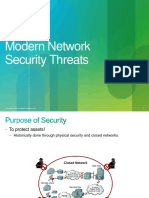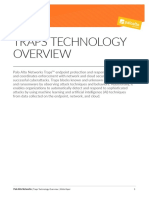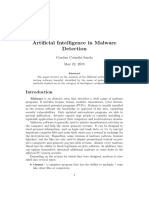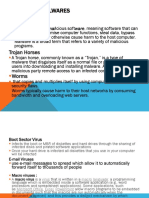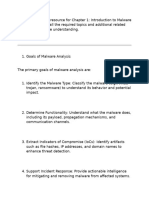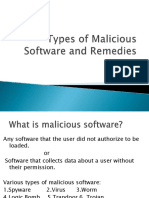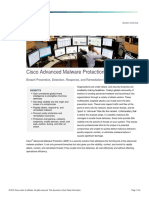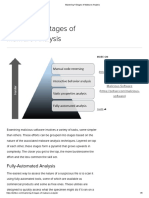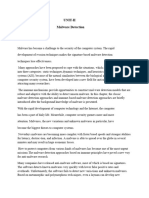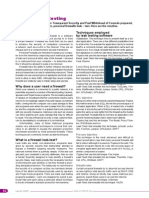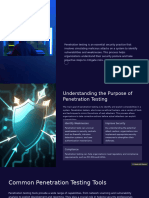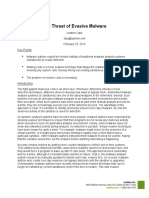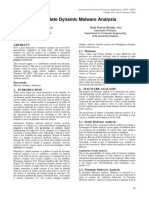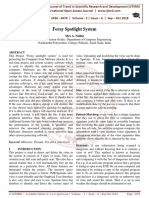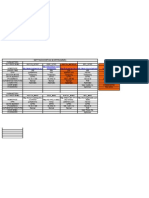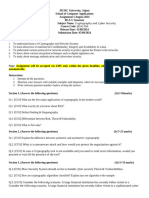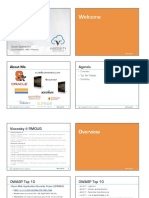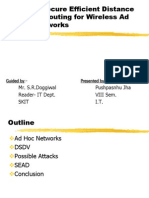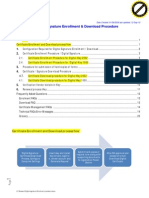Paloalto Traps
Paloalto Traps
Uploaded by
இளங்கோ இரத்தினவேல்Copyright:
Available Formats
Paloalto Traps
Paloalto Traps
Uploaded by
இளங்கோ இரத்தினவேல்Original Description:
Copyright
Available Formats
Share this document
Did you find this document useful?
Is this content inappropriate?
Copyright:
Available Formats
Paloalto Traps
Paloalto Traps
Uploaded by
இளங்கோ இரத்தினவேல்Copyright:
Available Formats
PaloAlto Traps
It replaces traditional antivirus with a multi-method prevention approach that secures
endpoints against known and unknown malware and exploits before they can compromise a
system.
Employs Multi-method Prevention approach
Malware Prevention
Exploit Prevention
MALWARE PREVENTION EXPLOIT PREVENTION
Wild Fire Threat Intelligence: Pre-Exploitation:
a cloud-based malware analysis and threat Prevents execution of an exploit. Today’s exploit
intelligence repository which analyses threat kits search for vulnerabilities in the system and
intelligence from Palo Alto customer networks. then decide which attack to launch. Such
This is used to prevent KNOWN (& previously vulnerabilities are blocked by Traps.
seen) malware from compromising an endpoint.
Local Analysis: Technique-based exploit prevention:
examines a file structure on the local machine Blocks known and unknown techniques used by
itself to determine if it is malicious or harmless, by Hackers including zero-day attacks.
using Machine Learning technology. Traps blocks these techniques, thereby preventing
This is used to detect and prevent potentially exploitation attempts before they can compromise
UNKNOWN malware. endpoints.
Wild Fire – Full Analysis: Post-Exploitation:
Unrecognized files or those not known to Wild Fire Blocks attacks that escalate system privileges as
Intelligence network are submitted to Wild Fire for well as compromise of Operating system itself.
Full Analysis. This includes Static Analysis and
Dynamic Analysis.
Static Analysis – examining of file structure
Dynamic Analysis – the unknown file is
detonated in customized Sandbox while
additionally run the malware in Bare metal
to determine if it is Malicious or benign.
This detects some of the most evasive
types of malware.
Malicious Process Control:
Helps to identify if a typically risky application is
being launched by another application. This gives
fine-grain control over what applications can run
which processes as child processes. e.g.: MS Word
and Internet Explorer can launch additional
processes to run scripts.
All these above capabilities are also used to
prevent Malicious Macros from executing in MS
Word or MS Excel and thereby run child processes.
MALWARE PREVENTION capability uses :-
1. Wild Fire – Threat Intelligence on Cloud : a cloud-based malware analysis and threat
intelligence repository which analyses threat intelligence from Palo Alto customer networks.
This is used to prevent KNOWN (& previously seen) malware from compromising an endpoint.
2. Local Analysis : examines a file structure on the local machine itself to determine if it is
malicious or good, by using Machine Learning technology.
This is used to detect and prevent potentially UNKNOWN malware.
3. Wild Fire – Full Analysis :
Unrecognized files or those not known to Wild Fire Intelligence network are submitted to Wild
Fire for Full Analysis. This includes Static Analysis and Dynamic Analysis.
Static Analysis – examining of file structure
Dynamic Analysis – the unknown file is detonated in customized Sandbox while additionally run
the malware in Bare metal to determine if it is Malicious or benign. This detects some of the
most evasive types of malware.
4. Malicious Process Control:
Helps to identify if a typically risky application is being launched by another application. This
gives fine-grain control over what applications can run which processes as child processes.
e.g.: MS Word and Internet Explorer can launch additional processes to run scripts.
All these capabilities are also used to prevent Malicious Macros from executing in MS Word or
MS Excel and thereby run child processes.
EXPLOIT PREVENTION capabilities employ
1. Pre-Exploitation: Prevents execution of an exploit.
Today’s exploit kits search for vulnerabilities in the system and then decide which attack to
launch. Such vulnerabilities are blocked by Traps.
2. Technique-based exploit prevention :
Blocks known and unknown techniques used by Hackers including zero-day attacks.
Traps blocks these techniques, thereby preventing exploitation attempts before they can
compromise endpoints.
3. Post-Exploitation:
Blocks attacks that escalate system privileges as well as compromise of Operating system itself.
You might also like
- SANS FOR610 - Reverse-Engineering Malware: Malware Analysis Tools and TechniquesDocument40 pagesSANS FOR610 - Reverse-Engineering Malware: Malware Analysis Tools and TechniquesNhat Long NguyenNo ratings yet
- Template NIST800-30 - Table I-5 Dan I-7 - Adversarial Dan Non-AdversarialDocument22 pagesTemplate NIST800-30 - Table I-5 Dan I-7 - Adversarial Dan Non-AdversarialNovra YunandaNo ratings yet
- Chapter 1 - Modern Network Security ThreatsDocument143 pagesChapter 1 - Modern Network Security ThreatsNabila Fauzi100% (1)
- Question: He Faculty Remarks Part (Quality of Service) (LO3-5 Marks) There Are Four Key Parameters That De..Document1 pageQuestion: He Faculty Remarks Part (Quality of Service) (LO3-5 Marks) There Are Four Key Parameters That De..Mr PerfectNo ratings yet
- CertKingdom PCNSEDocument84 pagesCertKingdom PCNSEgurungeNo ratings yet
- Traps Technology: Palo Alto Networks - Traps Technology Overview - White PaperDocument9 pagesTraps Technology: Palo Alto Networks - Traps Technology Overview - White PaperPlacoNo ratings yet
- Artificial Intelligence in Malware Detection: Cosolan Cornelia Ionela May 22, 2018Document5 pagesArtificial Intelligence in Malware Detection: Cosolan Cornelia Ionela May 22, 2018Ionela CosolanNo ratings yet
- Traps: Advanced Endpoint ProtectionDocument2 pagesTraps: Advanced Endpoint ProtectionCesareNo ratings yet
- Malicious Software Detection, Protection & Recovery Methods A SurveyDocument11 pagesMalicious Software Detection, Protection & Recovery Methods A Surveyjaroddd666No ratings yet
- Unit 4Document7 pagesUnit 4lo leeeNo ratings yet
- Chapter 2 - Attacks, Concepts and TechniquesDocument21 pagesChapter 2 - Attacks, Concepts and TechniquesS. M. AkashNo ratings yet
- Antivirus TechnqiuesDocument25 pagesAntivirus TechnqiuesNitish KumarNo ratings yet
- Cisco Introduction To Cyber Security Chap-2Document9 pagesCisco Introduction To Cyber Security Chap-2MukeshNo ratings yet
- Types of Malwares: Trojan HorsesDocument12 pagesTypes of Malwares: Trojan HorsesPrateek SharmaNo ratings yet
- Malware Analysis GSBSB - RunDocument13 pagesMalware Analysis GSBSB - Runsoc2analystNo ratings yet
- Ethical Hacking - 4 - 1713781070911Document46 pagesEthical Hacking - 4 - 1713781070911cocshravan69No ratings yet
- Penetration Testing Fundamentals-2: Penetration Testing Study Guide To Breaking Into SystemsFrom EverandPenetration Testing Fundamentals-2: Penetration Testing Study Guide To Breaking Into SystemsNo ratings yet
- Types of Malwares: Trojan HorsesDocument12 pagesTypes of Malwares: Trojan HorsesNageen ChandNo ratings yet
- MalwareDocument65 pagesMalwarejordanbelfort388No ratings yet
- Module 2 System Security (Jerick Zen Sildo, Marc Sanchez)Document13 pagesModule 2 System Security (Jerick Zen Sildo, Marc Sanchez)Junel SildoNo ratings yet
- A Comparative Analysis of Open Source Automated Malware ToolsDocument5 pagesA Comparative Analysis of Open Source Automated Malware Toolsworood.n.89No ratings yet
- TLE10 Types of MalwaresDocument24 pagesTLE10 Types of MalwaresXavierNo ratings yet
- Digital Malware Analysis - V2Document33 pagesDigital Malware Analysis - V2apgnascimento96No ratings yet
- AMP DatasheetDocument6 pagesAMP DatasheetMed AbdouNo ratings yet
- Cisco AMP White PaperDocument6 pagesCisco AMP White PaperJayNo ratings yet
- Cours3-Malware Analysis and Reverse Engineeringv2 enDocument14 pagesCours3-Malware Analysis and Reverse Engineeringv2 enSalsaNo ratings yet
- Study Report On AntivirusDocument4 pagesStudy Report On Antivirusram9kumar678No ratings yet
- Week 9 Lecture 16 Information SecurityDocument36 pagesWeek 9 Lecture 16 Information SecurityZulkifl HasanNo ratings yet
- Stages of Malware AnalysisDocument6 pagesStages of Malware Analysissantoshs2002848No ratings yet
- End 6Document4 pagesEnd 6johngete0015No ratings yet
- Malware FilteringDocument11 pagesMalware Filteringmkesav3070No ratings yet
- Unit Ii AisDocument26 pagesUnit Ii AisRajNo ratings yet
- Response Itsec2 Ex1 MalwareDocument7 pagesResponse Itsec2 Ex1 Malwaretanmaya1991No ratings yet
- TICsDocument6 pagesTICsaperezlombardiNo ratings yet
- Week 4 - Malware ForensicsDocument8 pagesWeek 4 - Malware Forensicsmosesd154No ratings yet
- Penetration TestingDocument28 pagesPenetration TestingNour BushNo ratings yet
- Endpoint Security TechniquesDocument6 pagesEndpoint Security TechniquesVikasNo ratings yet
- Ransom PlaybookDocument5 pagesRansom Playbookahmethan3572No ratings yet
- Firewall Leak TestingDocument6 pagesFirewall Leak TestingdasxaxNo ratings yet
- CSS 11 Q3 Wk2Document8 pagesCSS 11 Q3 Wk2jaimelovenaNo ratings yet
- Lect 6 Security of Network, Systems, ApplicationsDocument28 pagesLect 6 Security of Network, Systems, ApplicationscatizfavsNo ratings yet
- Anti Virus Best Practices PDFDocument8 pagesAnti Virus Best Practices PDFkprasad_mlNo ratings yet
- What Is MalwarDocument5 pagesWhat Is MalwarMajid GorsiNo ratings yet
- Computer Security: Principles and PracticeDocument27 pagesComputer Security: Principles and PracticeBahtera ProjectNo ratings yet
- Metasploit - Framework-A Quick Reference PDFDocument81 pagesMetasploit - Framework-A Quick Reference PDFsavanpatel16No ratings yet
- Article 7Document9 pagesArticle 7Canberk AkbaşNo ratings yet
- Malware Classification & DamagesDocument7 pagesMalware Classification & Damagesnusha2907No ratings yet
- Penetration Testing Tools An OverviewDocument5 pagesPenetration Testing Tools An Overviewyokesh waranNo ratings yet
- Tools For Penetration TestingDocument5 pagesTools For Penetration Testingm64305750No ratings yet
- Evasive - Threats For MalwareDocument8 pagesEvasive - Threats For MalwareDaniel JonesNo ratings yet
- Dynamic Malware AnalysisDocument6 pagesDynamic Malware AnalysisBik AshNo ratings yet
- 14.1.11 Lab - Anatomy of MalwareDocument2 pages14.1.11 Lab - Anatomy of Malwarediscordholder132No ratings yet
- CC101 - Module 11Document7 pagesCC101 - Module 11Regindin LauriceNo ratings yet
- Metasploit Framework by Achilli3stDocument81 pagesMetasploit Framework by Achilli3stSavan Patel100% (1)
- oldqansDocument15 pagesoldqans2023mt12270No ratings yet
- TicsDocument6 pagesTicsaperezlombardiNo ratings yet
- Computer Security AssignmentDocument3 pagesComputer Security Assignmenttehseeninter0% (1)
- Explain Vulnerability, Threat, Attack & Control in Relation To Computer IntrusionDocument8 pagesExplain Vulnerability, Threat, Attack & Control in Relation To Computer Intrusionb meherbabaNo ratings yet
- Q1) .Write The Procedure For Malware Dynamic Analysis? Ans)Document3 pagesQ1) .Write The Procedure For Malware Dynamic Analysis? Ans)Sparsh SrivastavaNo ratings yet
- Erbil Technical University Soran Technical Institute IT Department Second StageDocument8 pagesErbil Technical University Soran Technical Institute IT Department Second StageHero EnglishNo ratings yet
- Foray Spotlight SystemDocument3 pagesForay Spotlight SystemEditor IJTSRDNo ratings yet
- Theory TimeTable SYBSC CSDocument4 pagesTheory TimeTable SYBSC CSpinkuchopra17No ratings yet
- Malware Analysis Techniques: Tricks for the triage of adversarial softwareFrom EverandMalware Analysis Techniques: Tricks for the triage of adversarial softwareNo ratings yet
- Penetration Testing Fundamentals -1: Penetration Testing Study Guide To Breaking Into SystemsFrom EverandPenetration Testing Fundamentals -1: Penetration Testing Study Guide To Breaking Into SystemsNo ratings yet
- Securing Networks With Cisco Firepower Next Generation Firewall SSNGFWDocument5 pagesSecuring Networks With Cisco Firepower Next Generation Firewall SSNGFWkalidNo ratings yet
- Guideline OpenVPN Access Server - GoogleAuthApp PDFDocument18 pagesGuideline OpenVPN Access Server - GoogleAuthApp PDFGuile GallegoNo ratings yet
- 1.1.1 The Security LandscapeDocument2 pages1.1.1 The Security LandscapeAshley AllenNo ratings yet
- CISSP Exam QuestionsDocument57 pagesCISSP Exam Questionshaashim brown0% (1)
- Lecture 3 Protection and SecuirtDocument33 pagesLecture 3 Protection and SecuirtNadeem ShoukatNo ratings yet
- Gprs&Mms Data1Document1 pageGprs&Mms Data1api-3842047No ratings yet
- GofamenowwDocument6 pagesGofamenowwlemeec yopiNo ratings yet
- Password Safe Vs PI Vs PRA Vault ComparisonDocument1 pagePassword Safe Vs PI Vs PRA Vault ComparisonabsankareNo ratings yet
- Unit 5 Database Security and AuditingDocument36 pagesUnit 5 Database Security and Auditingtiwarisapana036No ratings yet
- CB Insights Future Data Security 1901Document27 pagesCB Insights Future Data Security 1901Dilyana GeorgievaNo ratings yet
- Group 4 Presentation Physical SecurityDocument36 pagesGroup 4 Presentation Physical SecurityTanaka MatendNo ratings yet
- Cryptography Assignment 1Document2 pagesCryptography Assignment 1Abhi SainiNo ratings yet
- Secure Socket Layer (SSL) : Divey Gupta Sunny Gajjar B.Tech-IV Computer Engg. NIT-SuratDocument22 pagesSecure Socket Layer (SSL) : Divey Gupta Sunny Gajjar B.Tech-IV Computer Engg. NIT-SuratSunny Kishorbhai GajjarNo ratings yet
- Index: S.No - Program Date RemarksDocument24 pagesIndex: S.No - Program Date RemarksAyush BhatNo ratings yet
- CDNetworks Web Application Firewall Product BrochureDocument2 pagesCDNetworks Web Application Firewall Product Brochureandini eldanantyNo ratings yet
- PAN ACE7.0 100% PassDocument112 pagesPAN ACE7.0 100% PassRobert Martin87% (31)
- Integrating UEBA With Zero TrustDocument23 pagesIntegrating UEBA With Zero TrustJayavignesh ZohoNo ratings yet
- English Preparation Guide Exin Isfs 201403 PDFDocument16 pagesEnglish Preparation Guide Exin Isfs 201403 PDFmakoua1983No ratings yet
- SpendoliniAPEX Security ChecklistDocument38 pagesSpendoliniAPEX Security ChecklistAlaa Eldeen M ANo ratings yet
- DSDVDocument36 pagesDSDVShainil AroraNo ratings yet
- Merkle Hellman KnapsackDocument42 pagesMerkle Hellman KnapsackchitrgNo ratings yet
- Ransomware Attacks The Next Consequence of The Coronavirus OutbreakDocument7 pagesRansomware Attacks The Next Consequence of The Coronavirus OutbreakMose KaranjaNo ratings yet
- Privacy Security For IotDocument39 pagesPrivacy Security For Iotrachelevelynr9007.sseNo ratings yet
- Junior Cyber Security Analyst - Template 16Document2 pagesJunior Cyber Security Analyst - Template 16recharge5ideaNo ratings yet
- Tms Messageusageguide 7.0 Key DownloadingDocument198 pagesTms Messageusageguide 7.0 Key DownloadingHenry S. AdkinNo ratings yet
- File5983othdoc0 1284352860890Document21 pagesFile5983othdoc0 1284352860890pkm_77No ratings yet


